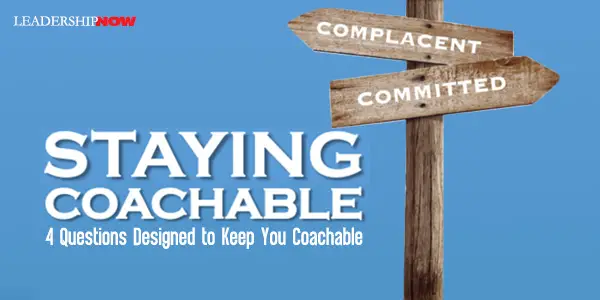 |
 |
01.07.22

Staying Coachable
FAR too many people accept their current reality as what will be. “Each day,” says Sean Glaze, “we are faced with two options. Either we choose the path of complacency, or we chose the path of commitment” to improvement and growth.” We often begin to look for external solutions for the frustration we feel. But we take that frustration with us wherever we go. The solution is to deal with what is going on inside of us. But instead of growing, we are rearranging. We want circumstances to change rather than change ourselves. When the dust settles, more often than not, all of the rearranging will result in the same frustration in a new context. This makes Sean Glaze’s book Staying Coachable so relevant and important for our times. It’s an engaging story about a father and a son—Wallace and Max—who decide to hike The Narrows in Zion National Park. Both are frustrated—Wallace over changes at work he is resisting, and Max over the new coach and basketball tryouts. On the hike, they meet Gayle, a wise woman who listens and agrees to help them with their frustrations if they are committed to change and growth. Gayle shares the lessons her husband learned as a coach before he died and she experienced in her own career. My husband used to say, “frustration is a magnificent and powerful tool. Like a hammer, you can use it to build something impressive—or wreck something you worked hard to build.” Staying coachable is a commitment to growth. “Being uncoachable is really about being stuck in a comfort zone that a person refuses to acknowledge or leave.” Glaze says there are four main ceilings that limit our growth: the ceiling of contentment, ignoring reality, personal pride, and knowing without doing. After they part ways, she agrees to share four questions they will have to grapple with over the ensuing months if they are committed to getting unstuck and improving. Four weeks later, the first question comes, and it is about hunger: What specifically do you want? Where do you want to be by when? Who are you trying to impress? You have to want something enough to disrupt the inertia of the status quo. Question two deals with honesty: Where are you now? What “numbers” accurately measure your desired performance? What obstacles exist to achieving the success you seek? This is hard because “many people find it difficult to acknowledge where and what they are without prejudice.” If you want directions anywhere, you must pinpoint the place you are starting from. Question three deals with our willingness to accept help—humility: How do you respond to mistakes or criticism? Who are a few valuable mentors that you can learn from? This question is meant to “inspire you to reflect on how you have handled feedback or the people who shared advice with you in the past. You can’t pour growth into a cup already full of assumptions and ego.” Criticism is not a dead-end; it is a detour to somewhere better. The final question comes down to habits: What will you do differently? What are you doing occasionally that you will now do consistently? What are the current distractions that you will stop doing? Your habits are external evidence of your internal commitments. Staying Coachable is a book for everyone. And there is not a better time than the present to read and apply the lessons found throughout this book. Stay coachable! 
Posted by Michael McKinney at 01:22 PM
|
BUILD YOUR KNOWLEDGE
 

How to Do Your Start-Up Right STRAIGHT TALK FOR START-UPS 
Grow Your Leadership Skills NEW AND UPCOMING LEADERSHIP BOOKS 
Leadership Minute BITE-SIZE CONCEPTS YOU CAN CHEW ON 
Classic Leadership Books BOOKS TO READ BEFORE YOU LEAD |